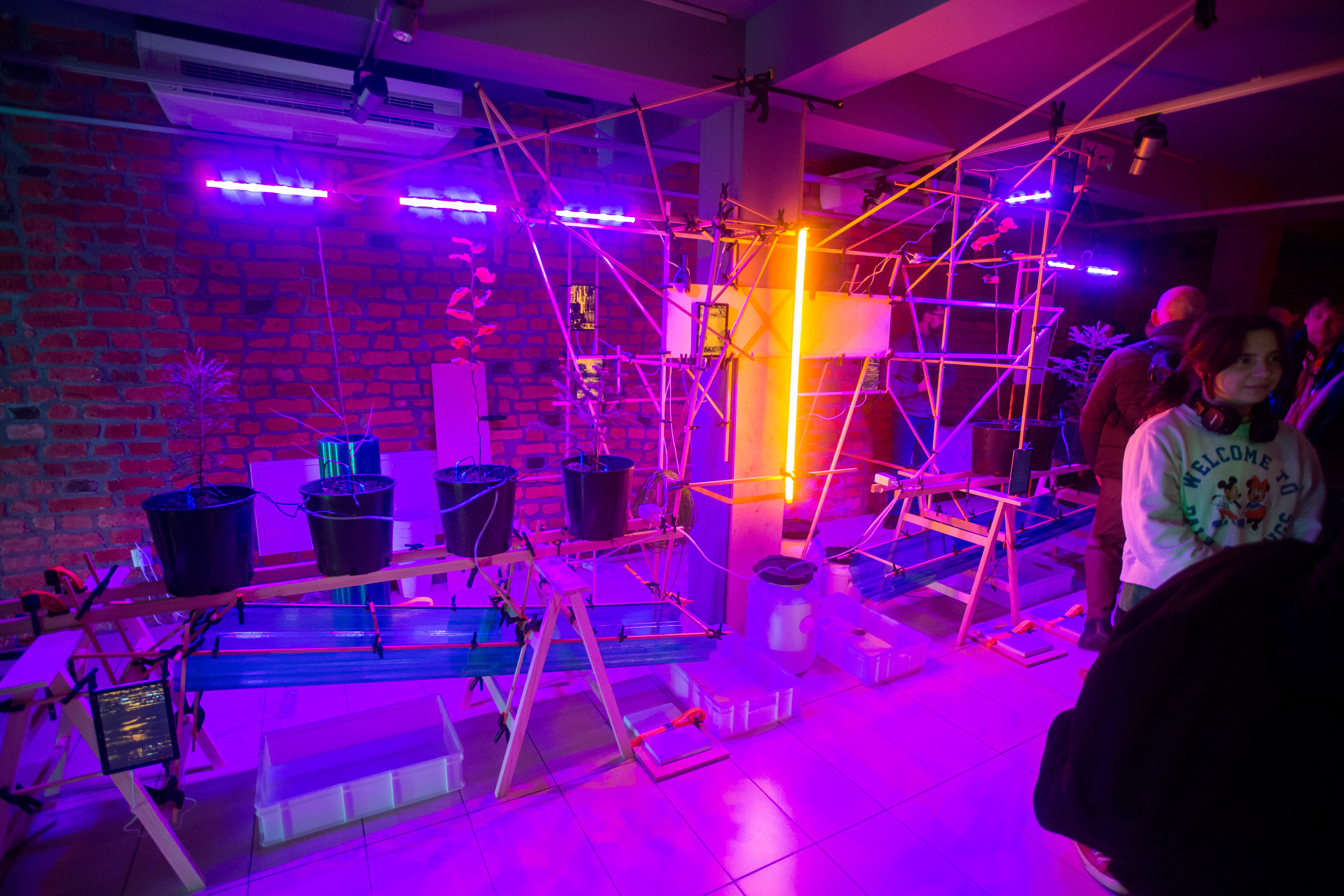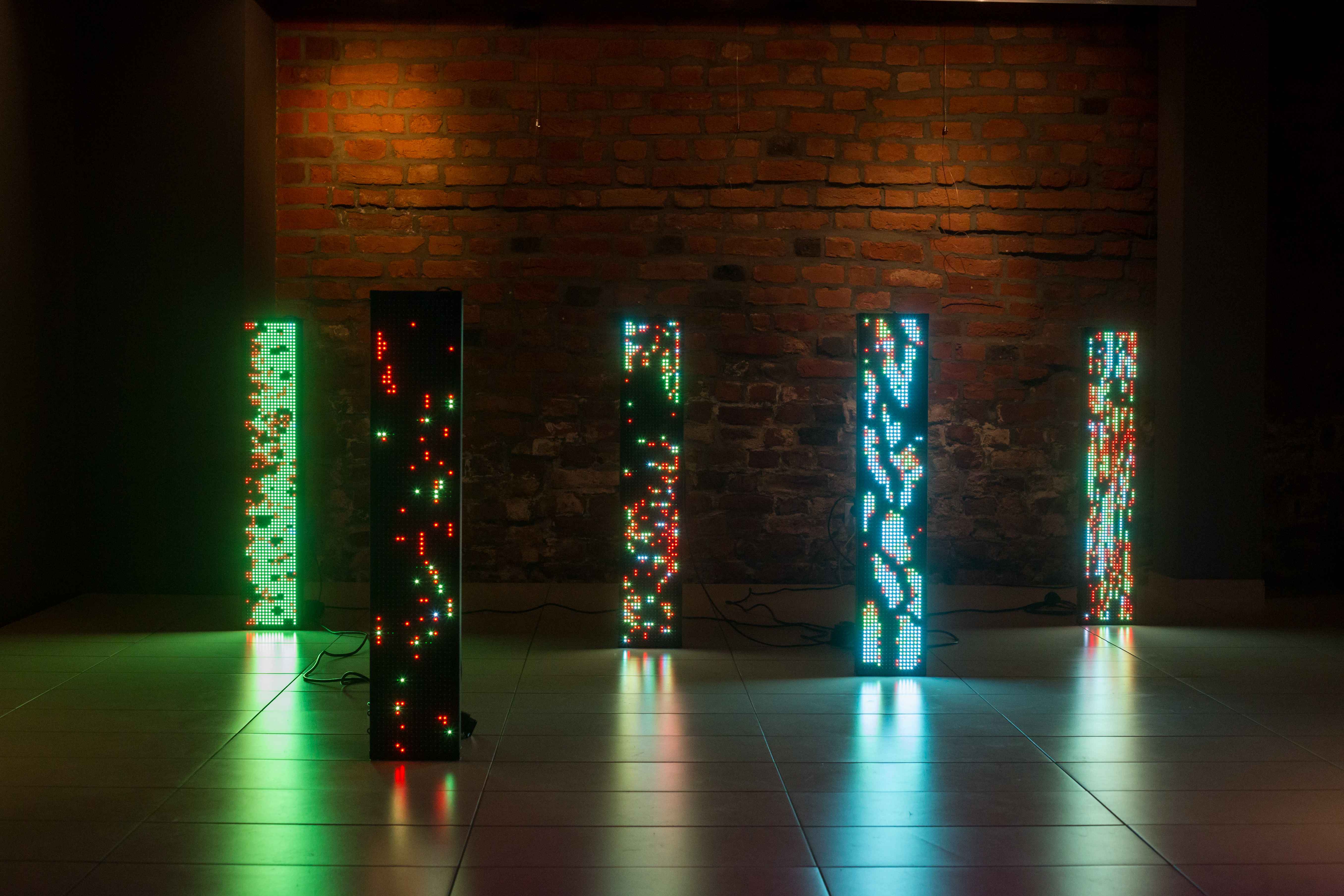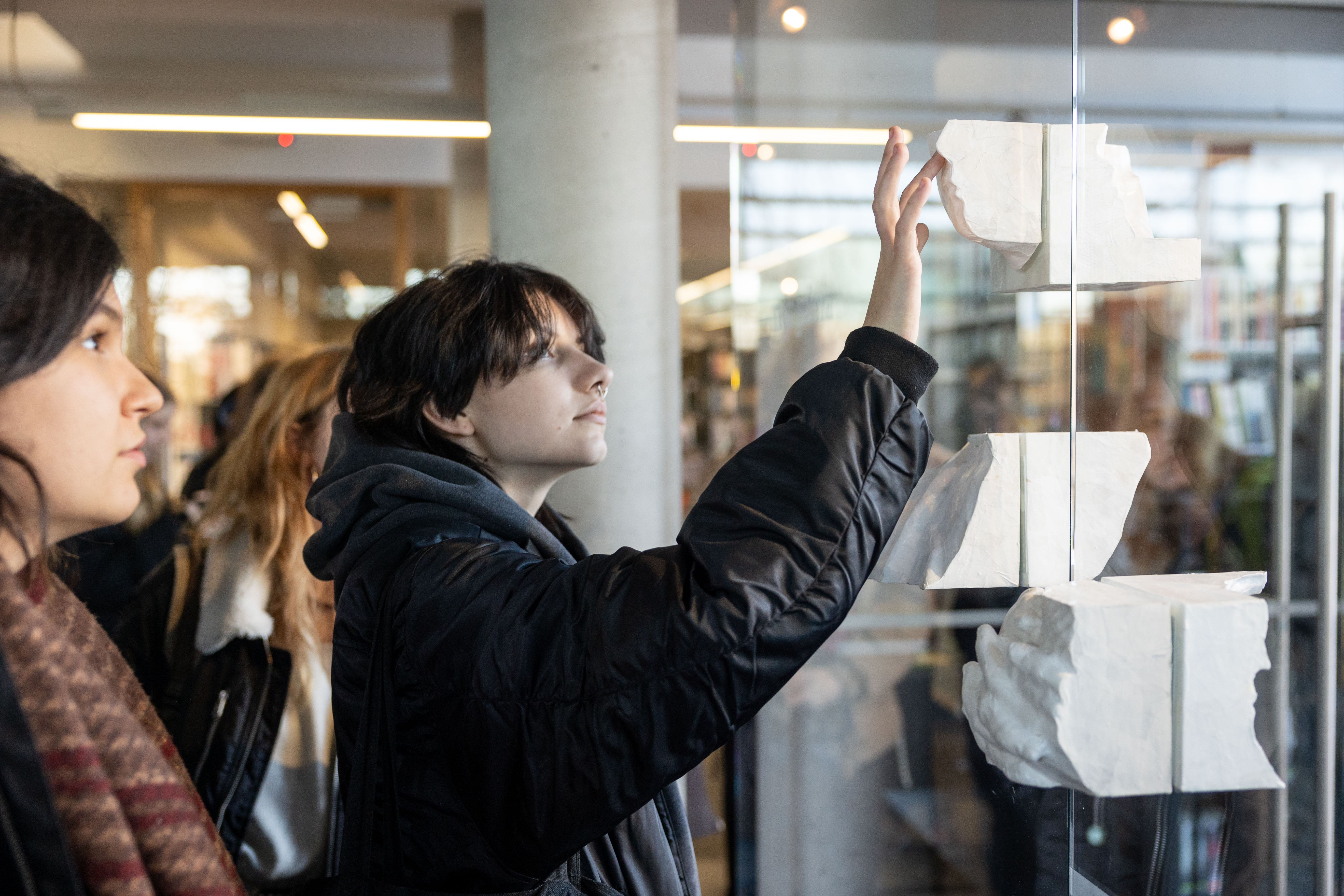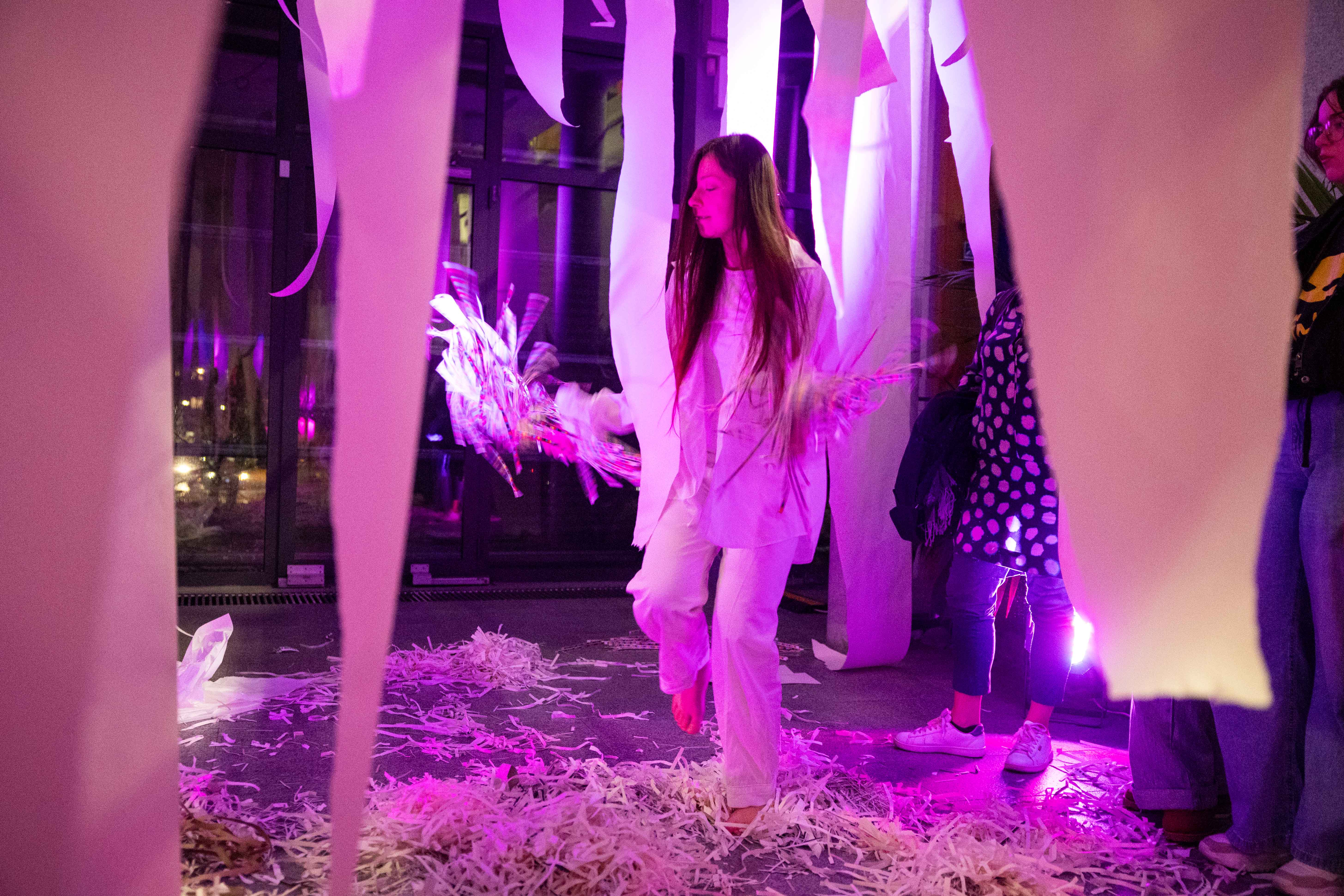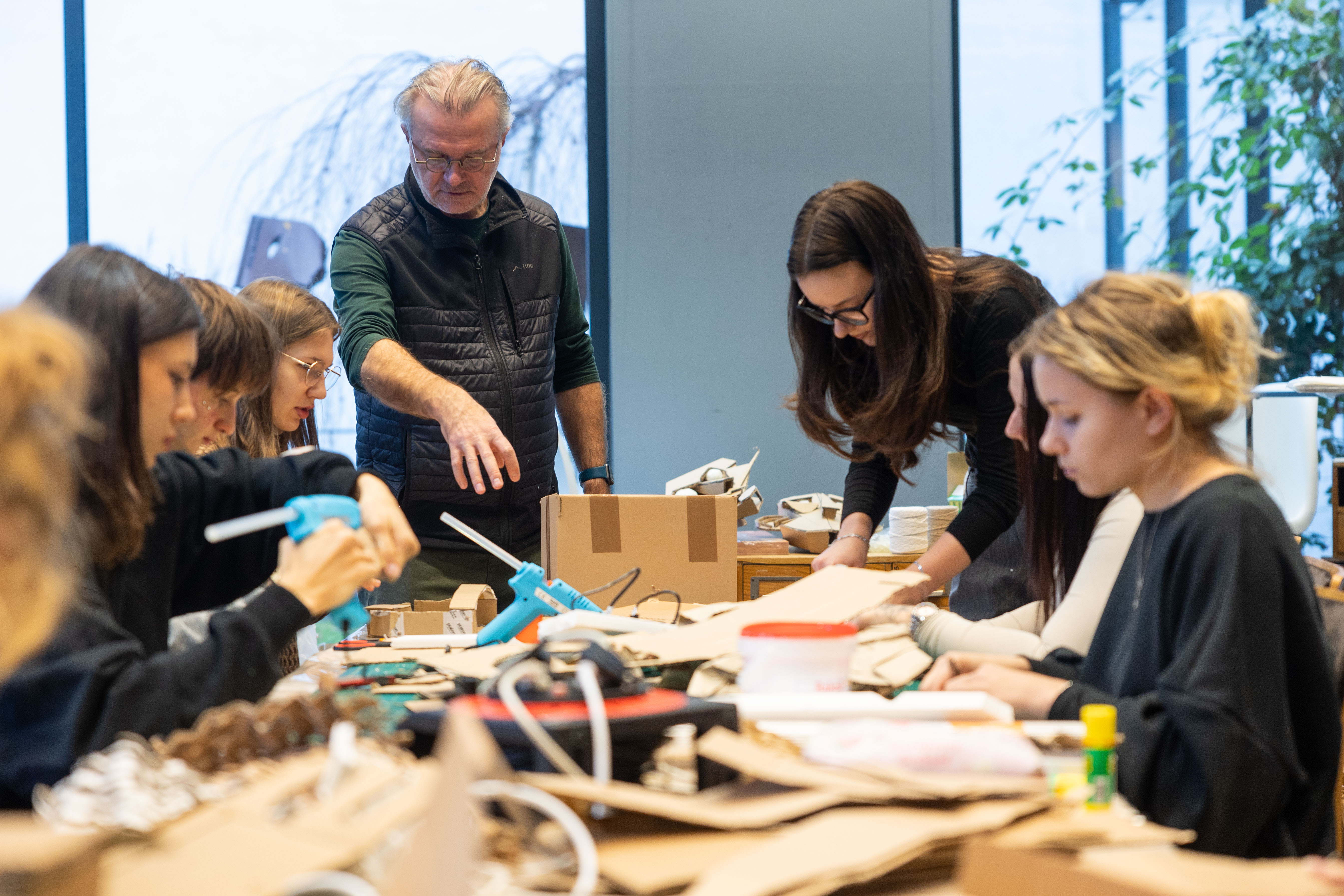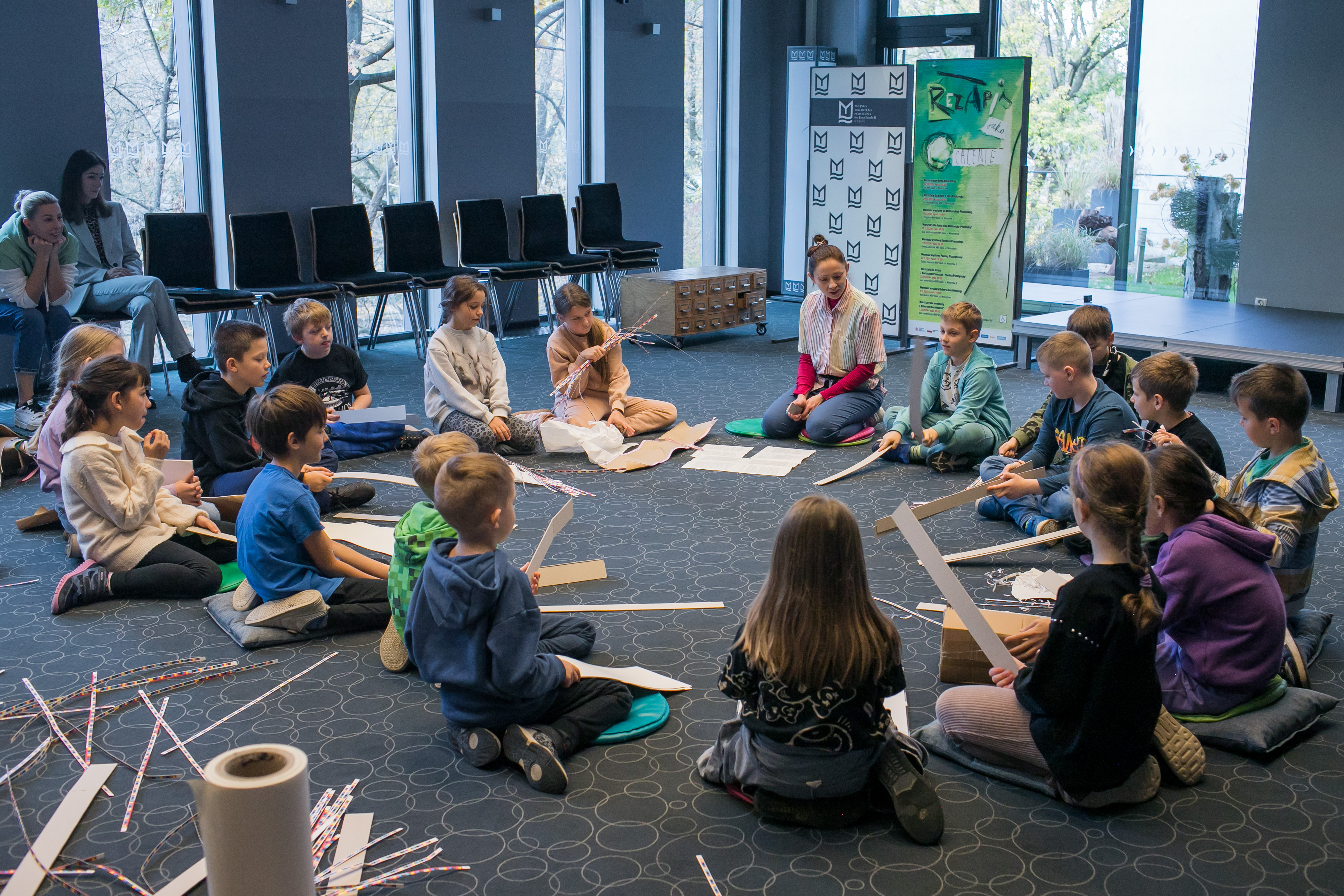Reconnecting with nature
Recommitment: Salvaging Paper
Recommitment to Paper as a Way to Salvage
The exhibition "Recommitment to Paper as a Way to Salvage" explores the environmental impact of paper, highlighting the need for sustainable practices in its production and use. Through sculpture, illustration, performance, and multimedia, the show examines paper’s dual role as an artistic medium and ecological product. With installations and workshops, it encourages reflection on how small actions can lead to a more sustainable future, fostering creativity and environmental responsibility.
Poland
Local
The city of Opole, Opole Voivodeship
Mainly urban
It refers to other types of transformations (soft investment)
Yes
2024-12-31
Yes
Program: National Recovery Plan, Program for Supporting the Activities of Entities in the Culture and Creative Industries Sector to Stimulate Their Development (KPO for Culture)
Strand/Action Line: Culture and Creative Industries
Year: 2024 (under the #NextGenerationEU initiative)
No
No
As a representative of an organisation
“Recommitment to Paper as a Way to Salvage” is an innovative artistic and educational initiative implemented by the Municipal Public Library in Opole from October 1 to December 31, 2024. Its overall aim was to explore the cultural and ecological significance of paper—transforming a ubiquitous yet environmentally impactful material into a catalyst for creative expression, sustainable practices, and community engagement. The project targeted diverse local groups, including children, youth, families, and community members. It achieved its objectives through a rich program of exhibitions, interactive performances, and hands-on workshops. Renowned artists such as Vena Naskręcka, Ola Woldańska-Płocińska, dr hab. Bartosz Posacki, dr Paulina Ptaszyńska, and Robert Suchiński approached the theme from multiple perspectives. Activities ranged from recycled paper installations and interactive sound performances to family workshops on creating eco-friendly toys and traditional papermaking sessions. Collaborations with local institutions, including the Opole Forest District (which provided tree saplings) and Opolgraf S.A. (which supplied recycled paper), further reinforced the project’s environmental commitment. The project embodies New European Bauhaus values by integrating sustainability, inclusivity, and aesthetic innovation. It promotes sustainable development through recycling and reuse, fosters social inclusion by engaging various community segments in creative and educational activities, and enhances the cultural landscape by merging art, ecology, and technology. In the long term, “Recommitment to Paper as a Way to Salvage” is expected to improve community life by raising environmental awareness, inspiring sustainable practices, and building resilient, culturally enriched urban spaces. This project serves as a model for how cultural institutions can address local ecological challenges and stimulate positive social change through creative, interdisciplinary collaboration.
Art
Ecology
Sustainability
Community
Recycling
The primary sustainability objectives of “Recommitment to Paper as a Way to Salvage” were to raise environmental awareness about the impact of paper production, promote recycling and the reuse of paper, integrate ecological education with creative arts, and foster community engagement in sustainable practices.
The project highlighted the environmental footprint of paper production, including deforestation, water consumption, and pollution. Through exhibitions and interactive installations made from recycled paper, participants were encouraged to reconsider paper not merely as waste but as a valuable resource with new potential.
By incorporating recycled materials into artistic works and facilitating workshops on traditional papermaking, the project provided practical demonstrations of how recycling can be creatively applied. These hands-on experiences reinforced the importance of reducing waste and utilizing resources more efficiently.
The initiative merged artistic expression with environmental education. Artists used their work to explore themes of sustainability, while workshops engaged various age groups—children, youth, and families—in activities that fostered a deeper understanding of ecological issues. This interdisciplinary approach nurtured a connection between art and nature, making sustainability tangible and relatable.
Collaboration with local institutions, such as the Opole Forest District and Opolgraf S.A., was central to the project. These partnerships not only supplied materials (like tree saplings and recycled paper) but also connected the artistic endeavors to concre
The project is exemplary in its holistic approach to sustainability. It demonstrates how cultural institutions can drive environmental responsibility by creating spaces where art, education, and community collaboration converge.
The project highlighted the environmental footprint of paper production, including deforestation, water consumption, and pollution. Through exhibitions and interactive installations made from recycled paper, participants were encouraged to reconsider paper not merely as waste but as a valuable resource with new potential.
By incorporating recycled materials into artistic works and facilitating workshops on traditional papermaking, the project provided practical demonstrations of how recycling can be creatively applied. These hands-on experiences reinforced the importance of reducing waste and utilizing resources more efficiently.
The initiative merged artistic expression with environmental education. Artists used their work to explore themes of sustainability, while workshops engaged various age groups—children, youth, and families—in activities that fostered a deeper understanding of ecological issues. This interdisciplinary approach nurtured a connection between art and nature, making sustainability tangible and relatable.
Collaboration with local institutions, such as the Opole Forest District and Opolgraf S.A., was central to the project. These partnerships not only supplied materials (like tree saplings and recycled paper) but also connected the artistic endeavors to concre
The project is exemplary in its holistic approach to sustainability. It demonstrates how cultural institutions can drive environmental responsibility by creating spaces where art, education, and community collaboration converge.
The key objectives of “Recommitment to Paper as a Way to Salvage” were to transform the library into a hub of creative expression and cultural enrichment, thereby enhancing the aesthetic quality and overall experience of its users. Through innovative design, interdisciplinary art, and interactive installations, the project aimed to create a multisensory environment that engages participants both visually and emotionally.
By reimagining paper as an artistic medium, the project challenged conventional perceptions of everyday materials, turning them into dynamic components of vibrant installations. This creative intervention not only enhanced the architectural and interior spaces of the Municipal Public Library in Opole but also inspired a sense of wonder and appreciation for the transformative power of art. Carefully curated exhibitions and immersive performances combined visual beauty, sound, texture, and aroma to evoke feelings of renewal, connection, and cultural pride.
Participatory workshops further elevated the quality of the experience by actively involving diverse audiences—from children to seniors—in the creative process. These sessions fostered hands-on engagement, artistic exploration, and collaborative creation, deepening the community’s appreciation for design and cultural heritage. In doing so, the project demonstrated that thoughtful design and artistic innovation can elevate public spaces into vibrant cultural centers that inspire creativity and strengthen community bonds.
Overall, “Recommitment to Paper as a Way to Salvage” stands as an exemplary model of how integrating aesthetics and cultural benefits can transform a traditional library into an inclusive, dynamic space for artistic and sensory experiences, setting a benchmark for future initiatives.
By reimagining paper as an artistic medium, the project challenged conventional perceptions of everyday materials, turning them into dynamic components of vibrant installations. This creative intervention not only enhanced the architectural and interior spaces of the Municipal Public Library in Opole but also inspired a sense of wonder and appreciation for the transformative power of art. Carefully curated exhibitions and immersive performances combined visual beauty, sound, texture, and aroma to evoke feelings of renewal, connection, and cultural pride.
Participatory workshops further elevated the quality of the experience by actively involving diverse audiences—from children to seniors—in the creative process. These sessions fostered hands-on engagement, artistic exploration, and collaborative creation, deepening the community’s appreciation for design and cultural heritage. In doing so, the project demonstrated that thoughtful design and artistic innovation can elevate public spaces into vibrant cultural centers that inspire creativity and strengthen community bonds.
Overall, “Recommitment to Paper as a Way to Salvage” stands as an exemplary model of how integrating aesthetics and cultural benefits can transform a traditional library into an inclusive, dynamic space for artistic and sensory experiences, setting a benchmark for future initiatives.
The project “Recommitment to Paper as a Way to Salvage” was designed to promote inclusion at multiple levels by ensuring accessibility, affordability, and equitable participation for all community members. Its key objectives in terms of inclusion were: all events - including exhibitions, interactive installations, and workshops - were offered free of charge and held in accessible public spaces such as the Municipal Public Library in Opole. This ensured that people of all ages, socioeconomic backgrounds, and abilities could participate without financial or physical barriers;the initiative embraced “design for all” principles by creating multisensory, interactive experiences that catered to diverse audiences. Activities were tailored for various skill levels, encouraging participation from children, youth, families, and seniors. This approach allowed participants to engage creatively, regardless of their background or prior experience in the arts; the project was developed with input from a broad range of stakeholders, including local institutions, community leaders, and representatives from marginalized groups. This participatory planning process fostered transparent decision-making and a sense of shared ownership, ensuring that the project addressed the needs and aspirations of the entire community; by reimagining the role of paper,a material ubiquitous in everyday life, as a medium for art and environmental reflection, the project challenged conventional norms and promoted innovative societal models. It demonstrated how cultural initiatives can simultaneously address environmental sustainability and social equity, inspiring new ways of thinking about community resilience and cultural participation. This project exemplifies how integrating accessibility, inclusive design, participatory governance, and innovative societal models can foster a more equitable and engaged society.
Citizens and civil society played a crucial role in the project "Recommitment to Paper as a Way to Salvage”, both as beneficiaries and active participants. The project engaged the local community through exhibitions, interactive installations, and educational workshops, fostering awareness of sustainable practices and environmental responsibility.
The public was actively involved in performances, particularly during Vena Naskręcka’s installation, where audience participation in creating "paper compositions" enhanced their engagement. Similarly, Robert Suchiński’s exhibition encouraged visitors to interact with the artwork, leaving their own imprints on paper sculptures.
Workshops targeted various age groups, from children to adults, emphasizing hands-on learning. Families created toys from recycled materials, while participants in Paulina Ptaszyńska’s and Bartosz Posacki’s workshops engaged in discussions on forest conservation and made eco-themed artworks. These activities deepened their emotional connection to environmental issues.
Additionally, community members took an active role in preserving nature by adopting tree saplings from Refugium-Arbor, committing to their long-term care. Local institutions, such as the Opole Forest District and Opolgraf S.A., supported the project by providing materials and expertise, strengthening collaboration between cultural and environmental sectors.
The involvement of citizens ensured the project’s real-world impact, inspiring ecological awareness and promoting sustainable artistic practices. This participatory approach fostered a sense of collective responsibility, reinforcing the idea that environmental protection is a shared effort between artists, institutions, and the public.
The public was actively involved in performances, particularly during Vena Naskręcka’s installation, where audience participation in creating "paper compositions" enhanced their engagement. Similarly, Robert Suchiński’s exhibition encouraged visitors to interact with the artwork, leaving their own imprints on paper sculptures.
Workshops targeted various age groups, from children to adults, emphasizing hands-on learning. Families created toys from recycled materials, while participants in Paulina Ptaszyńska’s and Bartosz Posacki’s workshops engaged in discussions on forest conservation and made eco-themed artworks. These activities deepened their emotional connection to environmental issues.
Additionally, community members took an active role in preserving nature by adopting tree saplings from Refugium-Arbor, committing to their long-term care. Local institutions, such as the Opole Forest District and Opolgraf S.A., supported the project by providing materials and expertise, strengthening collaboration between cultural and environmental sectors.
The involvement of citizens ensured the project’s real-world impact, inspiring ecological awareness and promoting sustainable artistic practices. This participatory approach fostered a sense of collective responsibility, reinforcing the idea that environmental protection is a shared effort between artists, institutions, and the public.
The project was a collaborative effort that brought together local, national, and European stakeholders, each contributing unique expertise and resources. Local: the Municipal Public Library in Opole served as the primary hub, offering its spaces for exhibitions, performances, and interactive workshops. Local institutions—such as the Opole Forest District (providing tree saplings) and Opolgraf S.A. (supplying recycled paper)—ensured the project’s ecological focus was grounded in community realities. Additionally, local media outlets played a vital role in promoting the events, thereby increasing community engagement and ensuring the project reached a broad audience. National: at the national level, the National Institute of Music and Dance operated the project within a larger cultural framework, linking it to national strategies in arts and education. Prominent figures from the University of Opole, including Bartosz Posacki and Paulina Ptaszyńska, contributed through the creation of innovative multimedia installations and by leading educational workshops. Their involvement not only enriched the artistic quality of the project but also bridged academic expertise with practical cultural initiatives.European Level: european funding, provided through the “Cultural & Creative Industries Development Program” under NextGenerationEU, was crucial for the project’s financial backing and broader strategic vision. Furthermore, international collaboration was enhanced by the participation of artists like Vena Naskręcka, whose involvement via the Erasmus+ program brought diverse perspectives and innovative approaches to the project. Added Value: This multi-level engagement fostered synergy: local stakeholders anchored the project in the community, national actors lent credibility, and European partners provided funding and innovation. Together, they transformed the library into a vibrant space celebrating art, education, and sustainability.
The project drew on a wide range of disciplines, including contemporary art, new media, performance art, historical and cultural studies, ecological science, and technology. Artists such as Vena Naskręcka (performance art), Ola Woldańska-Płocińska (illustration and design), Bartosz Posacki, and Paulina Ptaszyńska (new media and multimedia installations) showcased diverse artistic practices. Robert Suchiński’s work in sculpture and eco-art further enriched this blend. In addition to artistic disciplines, the project incorporated environmental education and sustainable development. Historical insights into European papermaking and its cultural significance were combined with ecological awareness—highlighting issues like deforestation, recycling, and the environmental impact of paper production. This was reinforced through collaborations with local environmental organizations such as the Opole Forest District, which provided tree saplings and fostered a direct link between art and nature.Representatives from these various fields interacted through collaborative workshops, joint exhibitions, and integrated installations held within the library. For instance, interdisciplinary workshops allowed participants to explore papermaking, creative recycling, and environmental sustainability simultaneously. Collaborations, such as using Arduino technology to simulate optimal tree growth conditions in an art installation, exemplified how technological innovation could intersect with ecological science and artistic expression.This fusion of disciplines added significant value by creating a holistic experience. It transformed traditional themes into dynamic, multi-layered narratives that deepened community understanding of both cultural heritage and sustainability. Ultimately, the interdisciplinary approach not only enriched the artistic output but also positioned the library as a vibrant hub for cultural exchange and environmental awareness.
The project distinguished itself through a groundbreaking interdisciplinary approach that transcended conventional library programs. While mainstream initiatives typically focus on literature and traditional educational activities, this project redefined the library’s role by transforming it into a dynamic cultural hub where art, ecology, technology, and history converged. Key innovative features included: the project combined contemporary art, new media, and performance with environmental education and historical insights into papermaking. This blend created a rich, multi-layered narrative that moved beyond the standard single-discipline approach often seen in cultural initiatives; Unlike traditional static exhibitions, the project featured interactive installations and workshops that invited participants to engage directly. For instance, innovative workshops allowed visitors to create sensory art experiences with recycled paper, merging creative expression with tangible environmental action; The use of modern technology, such as Arduino-controlled installations to simulate optimal tree growth conditions, demonstrated a forward-thinking integration of science and art. This aspect not only underscored the project’s commitment to sustainability but also provided an immersive learning experience; By involving international artists, local environmental organizations, and academic experts, the project created a collaborative network that enriched the overall experience. This synergy of diverse perspectives fostered a holistic approach to addressing cultural and ecological challenges.
Overall, the innovative character of the project lay in its ability to break down traditional silos—merging artistic creativity with scientific inquiry and environmental stewardship. This novel integration offered fresh, engaging ways to inspire community involvement and redefine the role of public libraries in promoting sustainability and cultural dialogue.
Overall, the innovative character of the project lay in its ability to break down traditional silos—merging artistic creativity with scientific inquiry and environmental stewardship. This novel integration offered fresh, engaging ways to inspire community involvement and redefine the role of public libraries in promoting sustainability and cultural dialogue.
The project employed a comprehensive, interdisciplinary approach that integrated art, technology, ecology, and education to create a dynamic, participatory experience. Its methodology was built around the following key elements: experts from diverse fields—contemporary art, new media, performance, illustration, sculpture, and environmental science-joined forces to reframe the narrative of paper. This cross-disciplinary dialogue enriched the creative process and deepened the exploration of paper’s cultural and ecological dimensions; Central to the approach was the active involvement of the community. Interactive installations and hands-on workshops allowed participants to engage directly with the material. Activities such as sensory experiments with recycled paper not only showcased its artistic potential but also highlighted the importance of sustainability through creative expression; The project leveraged modern technology to merge artistic creativity with scientific inquiry. For example, installations using Arduino technology simulated optimal tree growth conditions, effectively linking ecological science with artistic representation and reinforcing the environmental message; Tailored workshops catered to different age groups and backgrounds, blending artistic techniques with historical insights into papermaking and practical lessons on recycling and ecological responsibility. This educational component was designed to empower participants with both knowledge and hands-on experience; By partnering with local institutions, national organizations (such as the National Institute of Music and Dance), and European funding programs, the project secured broad support and aligned with wider cultural and sustainability initiatives. Overall, this approach transformed the library from a traditional literature repository into a vibrant hub for cultural exchange and environmental education, delivering an immersive experience that challenged norms and inspired sustainability.
Several elements of the project are easily replicable across different settings, beneficiary groups, and contexts. The core approach—integrating art, environmental education, and technology—can be adapted by other institutions to explore local cultural and ecological themes. This model encourages collaboration among artists, scientists, and educators, creating a holistic framework for community engagement. The hands-on, participatory format used in our workshops, where visitors created art from recycled paper and engaged in sensory experiences, can be tailored to various materials or themes. Such activities stimulate creativity and promote environmental awareness, making them adaptable to diverse audiences.The use of modern tools (e.g., Arduino-based installations to simulate ecological processes) demonstrates how technology can enhance artistic and educational projects. This aspect is transferable to other initiatives aiming to blend digital innovation with sustainability practices.Our strategic partnerships with local institutions (like environmental organizations and media), national cultural bodies, and European funding programs provided a robust support system. This network model can be emulated elsewhere, ensuring broader community involvement and resource sharing.The production of bilingual, digital catalogs and video profiles for disseminating project results offers a replicable strategy for documentation and outreach. These tools help in preserving the project’s legacy and promoting its impact to a wider audience.Overall, the project’s blend of methodologies, technologies, and collaborative processes provides a versatile template. It can inspire similar initiatives in libraries, museums, community centers, and educational institutions, fostering cultural exchange and promoting sustainable practices across different regions and contexts.
The project addresses several global challenges by offering localized, community-driven solutions. One major global issue is environmental degradation, particularly through deforestation and unsustainable resource consumption linked to paper production. By focusing on the lifecycle of paper—from production to recycling—the project raises awareness about these challenges and promotes responsible consumption. Locally, it encourages creative reuse and recycling practices, transforming waste into art and educational materials, which in turn fosters a culture of sustainability.
Another global challenge is the lack of public engagement in environmental stewardship. By integrating art, technology, and interactive workshops, the project turns passive audiences into active participants. These hands-on experiences—such as creating installations from recycled paper and engaging with technological simulations of ecological processes—empower communities with practical knowledge and foster behavioral changes that support sustainability.
Additionally, the project contributes to global efforts in combating climate change. Through collaborations with local environmental organizations like the Opole Forest District, it supports reforestation and biodiversity initiatives. This not only mitigates carbon emissions but also strengthens local ecosystems, providing a replicable model for integrating ecological action with cultural expression.
Overall, by merging artistic creativity, technological innovation, and environmental education, the project creates a local blueprint for addressing widespread challenges. It illustrates how community-based initiatives can drive global sustainability efforts, making environmental responsibility tangible, accessible, and engaging for diverse audiences.
Another global challenge is the lack of public engagement in environmental stewardship. By integrating art, technology, and interactive workshops, the project turns passive audiences into active participants. These hands-on experiences—such as creating installations from recycled paper and engaging with technological simulations of ecological processes—empower communities with practical knowledge and foster behavioral changes that support sustainability.
Additionally, the project contributes to global efforts in combating climate change. Through collaborations with local environmental organizations like the Opole Forest District, it supports reforestation and biodiversity initiatives. This not only mitigates carbon emissions but also strengthens local ecosystems, providing a replicable model for integrating ecological action with cultural expression.
Overall, by merging artistic creativity, technological innovation, and environmental education, the project creates a local blueprint for addressing widespread challenges. It illustrates how community-based initiatives can drive global sustainability efforts, making environmental responsibility tangible, accessible, and engaging for diverse audiences.
The project achieved significant results and impacts across artistic, educational, and ecological dimensions, aligning perfectly with the applied category. The transformation of the local library into a vibrant cultural hub redefined its role in the community. By hosting interactive installations and hands-on workshops, the project created a space where art, history, and ecology converged, attracting diverse audiences and promoting interdisciplinary dialogue. Direct beneficiaries—ranging from children to adults—gained new skills in creative recycling, eco-art, and interactive participation. Workshops enabled participants to explore sustainable practices through artistic expression, fostering a deeper understanding of environmental challenges such as deforestation and waste management. The initiative provided local artists, designers, and academic professionals with a platform to experiment with innovative techniques that integrate technology and ecology. Their collaborative efforts resulted in unique artistic productions and educational content that enriched the local cultural landscape.The project built a robust network by engaging local institutions (e.g., the Opole Forest District and local media), national organizations (like the National Institute of Music and Dance), and European funding bodies. This collaborative framework not only amplified the project’s reach but also set a replicable model for interdisciplinary and cross-sector partnerships.Indirect beneficiaries include the wider community, which now benefits from increased environmental awareness and improved cultural offerings. The project's success has inspired similar initiatives, promoting sustainable practices and cultural exchange in other regions. The project fostered community cohesion, boosted educational opportunities, and promoted sustainable cultural practices, leaving a lasting impact on both direct participants and the broader community.

